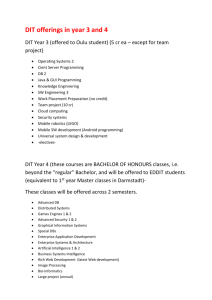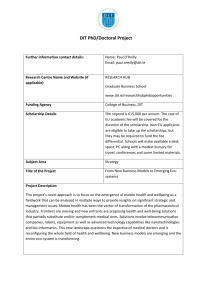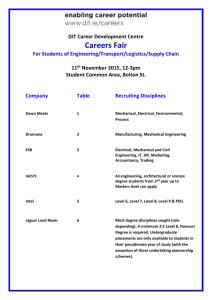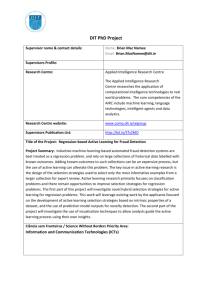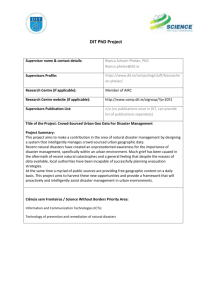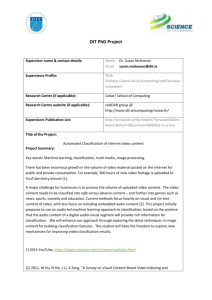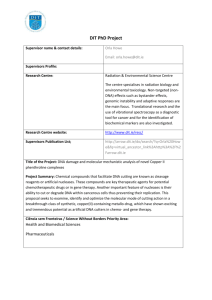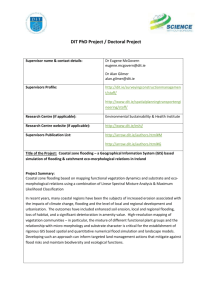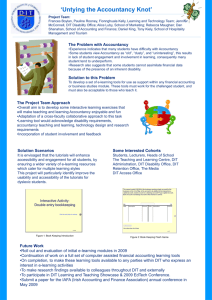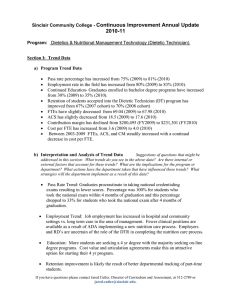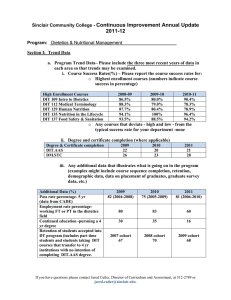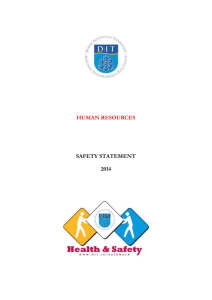Project Overview - Bryon Baumstarck
advertisement
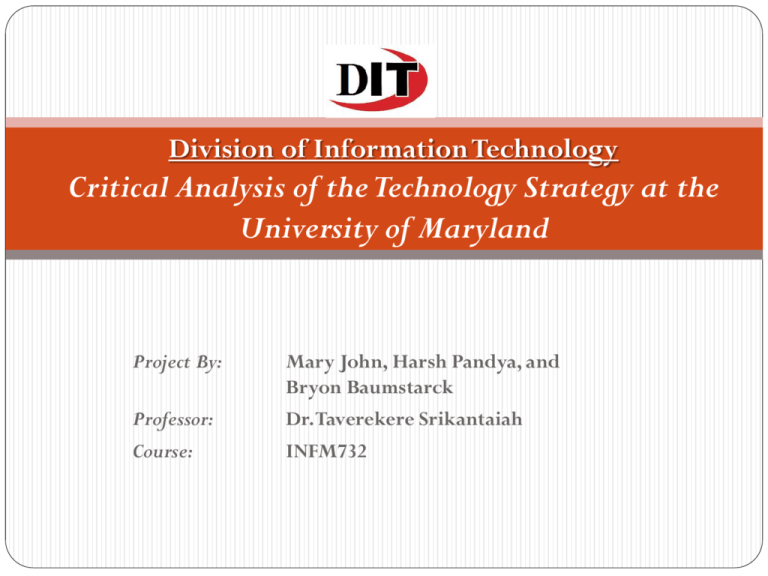
Division of Information Technology Critical Analysis of the Technology Strategy at the University of Maryland Project By: Professor: Course: Mary John, Harsh Pandya, and Bryon Baumstarck Dr. Taverekere Srikantaiah INFM732 Outline • Organizational Overview • Project Overview • Methodology • Summary of Findings • SWOT Analysis • Major Issues & Recommendations • Conclusion Organizational Overview • The DIT manages and monitors all networking and computer equipment for the University of Maryland – College Park campus. • Issues and enforces network usage policies, computer use policies, and provides server resources. • They are a strong and secured academic resource provider (ELMS, ARES, SIS, Testudo, etc.) • Strives to provide the University of Maryland with the state-of-the-art-and-beyond IT resources to enhance the University’s standard of excellence in education and research. Project Overview Project Rationale: “ To better understand the decision-making process of acquiring and managing technology within the setting of a large research university along with provide an understanding of how internal and external factors impact this decision-making process. “ Beneficiaries: 1. Students 2. Staff 3. Faculty 4. Researchers 5. Alumni Project Overview (cont.) Environmental Scanning Issues Why the network refresh project is not utilizing the latest networking technologies. Lack of utilization of the latest software as soon as it is released. Information Auditing Issues Lack of action on written policies. Inconsistency between written vision and actual practices. Methodology 1. Interview a) Conducted a 1-hour, personal interview with Gerry Sneeringer, the Director of IT Security at DIT. b) This interview focused on the internal auditing practices and the utilization of external information within DIT. 2. Website In addition, we also conducted an analysis of publicly available information from the DIT website. http://www.it.umd.edu/ Summary of Findings DIT strongly abides by their core values. Committed to the strategic vision and the strategic IT planning process. Committed to the implementation of the recommendations and action items in that plan. Working in collaboration with the university community. Dedicated to building a holistic IT environment across the campus. Committed to open, transparent, communications in their interactions. Graciously and thoughtfully accept critique from others, and embrace them as a team. Committed to the hallmark of a highly successful organization residing in the respect, collegiality, and care we have for each other in our professional interactions. SWOT Analysis STRENGTHS WEAKNESSES Strong customer / consumer base. Lack of critical resource management. Builds custom software for better control. Not utilizing the latest software / hardware. Extensive audit process. Irregular SWOT analysis process. Provide wide range of services within the Lack of awareness among university university. community, mainly undergraduate students. Lack of funding / grant control. OPPORTUNITIES THREATS Better promotion of DIT services Other technical service providers. New technological developments. Economic instability. Expand the scope of business to the New and continuing data and system security outside of the UMD perimeter challenges. Changes to university leadership. Major Issues Recommendations Change Management Process. Change Management Process. a) Very slow process. a) b) Use of Lifecycle mindset. c) Assumption that everyone is informed. Conduct more surveys for a better understanding. b) d) Lack of communication Connection Better mode of communication to the UMD community. Hierarchical Structure. Hierarchical Structure. a) Slow decision making process. a) Flatter team oriented structure. b) Bureaucratically Hierarchical in nature. b) Better team leadership, reporting and management. c) Assumption that everyone is informed about the latest happenings. d) Changes by the new Leadership. e) Limitations / control on fund/grants. c) Less micro management d) Encouragement to participate in the decision making process. Major Issues Recommendations Privacy & Security. Privacy & Security. a) a) Incorporate a special team to test and b) Provide access to research tools to both internal & external researchers. validate new standards-based Securing the privacy of sensitive technologies. personnel data. b) Provide more "innovative and leadingedge computing services". c) Utilizing of standards-based technologies. Conclusion Two sides of the same coin. Various unintended flaws within the organization. Serious considerations to the “recommendations” Improvement in the communication connection. Conduct thorough environmental scan and necessary information audit within the organization due to their organizational structure.
